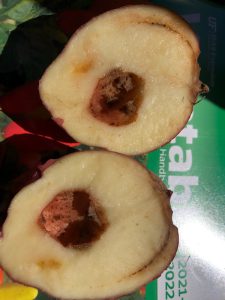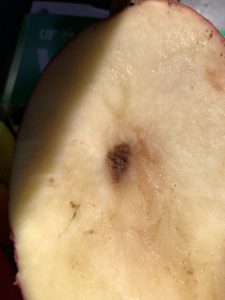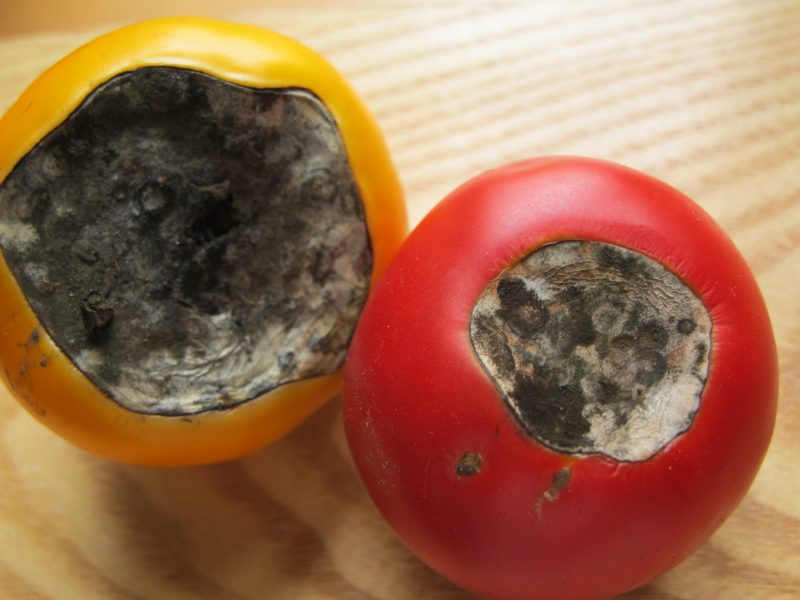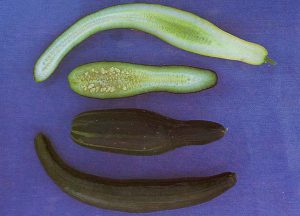ORIGINALLY PUBLISHED IN PANHANDLE AGRICULTURE E-NEWSLETTER / Northwest Extension District

Every spring and summer I perform site visits to vegetable growers to diagnose plant problems. This summer is no different, but I have found several instances of plant disorders that look like disease or insect damage, but really are not.
Whenever a problem is found on a vegetable or fruit plant that is not caused by an insect or disease, it is given the term abiotic, which means that is not caused by a biological organism. If an abiotic disorder is not caused by a biological organism (insect, fungi, bacteria, etc.), then what is the cause? While sometimes difficult to pinpoint the exact cause, it is usually some combination of nutrient deficiency or excess, climate factors, moisture factors or pesticide damage. Below are some examples of abiotic disorders I have seen in the field.
One common problem seen this year is potato hollow heart or brown center. Both conditions have similar causes. The disorder that causes hollow heart or broken center in the potato tuber is caused by cells that die inside when potatoes are growing too quickly or unevenly, such as when recovering from environmental stress or over fertilization.
The fact is potatoes may get stressed out by extremes. Weather conditions that may cause brown center are early season cool nights, which cause soil temperatures to be below the mid-50s for around a week or longer. Soil moisture at 80% or greater may also cause the same symptoms.

Hollow heart is typically caused by swings from low to high soil moisture and overapplication of nitrogen. To mitigate this condition, consistent irrigation practices and spit fertilizer applications have been shown to be effective. Additionally, if hollow heart or brown center is a typical problem for your growing area, selecting cultivars that are less susceptible to this condition is a good tactic, since there is quite a bit of variation among cultivars / varieties.
The final message is one of good news, if this is noticed at potato harvest this year, there are steps that can be taken to mitigate this issue in future growing seasons. For more information, please check out the reference for this article, UF/IFAS publication HS945 “Potato Physiological Disorders—Brown Center and Hollow Heart”
Blossom end rot (BER) is another common problem found in tomatoes, but not caused by a disease as quick observation might suggest. BER is caused by calcium deficiency but is usually a result of wet / dry cycles brought on by an inconsistent irrigation program on sandy, well drained soils. The best cure for blossom end rot (BER) is a consistent level of soil moisture throughout the fruiting cycle. In some cases, the soil is actually calcium deficient, so regular soil nutrient tests are beneficial.
Since tomatoes need a consistent supply of water to prevent blossom end rot, drip irrigation under plastic works well. Blossom end rot effects crops in the solanaceae family and appears as a grey, mushy dead area at the base of the vegetable.

–

Insufficient or inactive pollen
Although there are a few squash diseases that cause problems in the summer, sometimes squash turn yellow and fall off the plant for other reasons, such as lack of pollination. Cucurbits are dioecious, meaning they have separate male and female flowers on the same plant. Flowers are also tube shaped, so they do not allow for wind pollination. Thus, squash require various species of bee, beetle or fly for proper pollination. If insects do not visit the female squash flowers frequently enough with enough pollen, incomplete pollination will result. Incomplete pollination is easily mistaken for a disease.
For more information about cucurbit pollination, please read the following publication POLLINATION OF CUCURBITA SPP. (SQUASH AND PUMPKIN) CROPS IN FLORIDA ENY-2056
 1
1
